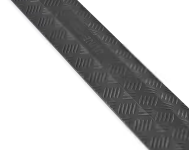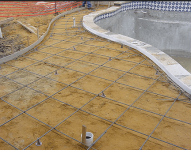I feel your pain. But the good news is that you've double confirmed the ladder is not bonded! On the other hand you must not have resonated with my post #156 because you did some other things instead

. So - your post #150 said you were going to try the bonding array tied to the
ladder only, disconnected from the rails but still tied to the pump/equipment pad, then re-testing voltages
from the rails to water and that would tell us once and for all whether the rails are
also unbonded. Maybe you did that and just didn't get a chance to write about it, or I missed that result.
I'm not sure why you're digging for another bonding wire to the niche. You won't find that - even if it's there it would be direct from the niche to the reinforcing frame and likely buried in concrete, completely inaccessible. You do have the niche bonding wire accessible in the J-box, and I suggested a couple resistance tests on that in order to verify whether or not it's bonded to the rest of the intact bonding - i.e. back to the pump/equipment pad. A lot easier than digging.
Pulling on the ladder is indeed a back breaker, I have no idea what's holding it, crusted into the anchor I guess. In past threads one person used a floor jack, perhaps raised on a solid platform of concrete blocks or some such so that the jack could exert pressure on "the loop". I guess I would do something similar with a bottle jack. If I only had a dollar for evey time my $10 bottle jack came in handy

A pool pro who apparently owns one of those pricey coring apparatus rigs just cuts the ladder flush and cores out the entire anchor assembly. The coring rig also pricey to rent as I looked at $250 for the day at Home Sleepo. I used
these for $40 with a hammer drill when coring just concrete, I imagine they would eat the brass/bronze anchor too (the bits are out of stock but there are similar offerings).
That's all I got - what did I miss? Good luck man!









